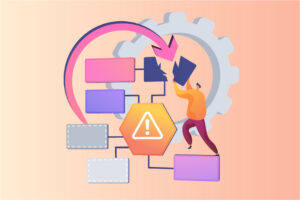
The term “business continuity and disaster recovery,” often known as BCDR, refers to a set of procedures and practices used to help an organization recover from a crisis and resume its regular business operations as soon as possible.
In the aftermath of a disaster, it is a wide notion that integrates the roles and functions of both information technology and business.
Following a disaster, BCDR ensures that normal tasks continue uninterrupted, with as little downtime as possible and no data loss.
The BCDR process can be broken down into two distinct phases or components:
Business Continuity, sometimes known as BC, is the part of BCDR that deals with business operations. It entails designing and creating policies and procedures that guarantee that vital company operations and processes will continue to run as usual in the event of a disaster.
The replacement of workers, problems with service availability, and change management are some examples of business continuity.
Disaster Recovery, commonly known as DR, focuses mainly on the information technology (IT) aspect of BCDR. It describes how the information technology department of a business will bounce back from a man-made or natural catastrophe.
Restoring servers and networks, making copies of backup data, and setting up backup systems are all examples of Disaster Recovery.
To mitigate the effects of unforeseen natural or man-made catastrophes, most medium and large businesses have an integrated BCDR strategy in place.

The ability of an organization to continue operations in the event of a catastrophe is a critical component of its overall risk management strategy.
Having a plan for business continuity without a plan for disaster recovery would be inefficient, and having a disaster recovery plan would not guarantee that business continuity would be maintained.
To reduce the adverse effects of a future disaster on a company’s operations, its business continuity and disaster recovery strategies must collaborate.
When a disaster strikes, a good business continuity plan ensures that critical business functions continue to run without interruption. However, it won’t be possible without having a robust disaster recovery plan in place. Good disaster recovery ensures that all information technology systems, software applications, and business applications can be accessed and recovered.
Business continuity and disaster recovery are both crucial to a company’s success because they detail the methods and procedures that must be taken before operations can be resumed following an interruption caused by an emergency.
A Business Continuity and Disaster Recovery plan details the actions that must be taken to ensure that essential business processes continue to run without interruption, as well as the procedures that must be followed to quickly restore IT systems and data in order to get business operations back up and running after a traumatic event.
A BCDR plan takes into account a wide range of potential outcomes. From the inadvertent deletion of data and failed hardware to the introduction of malicious software and catastrophic natural events.
A robust BCDR plan is a MUST for every business. Having a plan in place to ensure the continuity of business operations and recover quickly from any disasters helps firms get ready for situations that could disrupt their operations.
It improves a company’s capability to carry on with business as usual with minimal or no interruptions. A robust BCDR plan reduces the level of risk the organization might face in the event of a natural or man-made disaster.
A business without a BCDR plan in place is sure to vanish from the market or be unable to recover. In point of fact, the aftermath of widespread catastrophes can render activities impossible to continue. More than 90% of businesses that confront a major crisis without a DR strategy fail within a year.
A BCDR plan helps businesses by Reducing total risk and ensuring continuity of operations during interruptions or outages. Mitigating the risk of data loss and safeguarding the company’s reputation.
The business world is full of challenges, and the ones that are disaster-ready can be sure of their survival in the long run. Every business needs to be ready to respond to any type of disaster appropriately. Doing so can positively affect the partners and consumers they work with.
However, developing a SOLID BCDR plan needs subject matter knowledge and expertise. In the absence of these two, making the right BCDR plan is not possible.
So, what shall you do?
Worry not!
You can count on Metaorange Digital, we can help you become resilient and better prepared for unexpectedly disruptive occurrences.
With us, you can be sure of increased uptime, productivity, and confidence.
Our complete solutions, which interface directly with the cloud, make data protection, application spin-up, and Service Level Agreements (SLAs) easier. Our solutions are meant to provide you with archival durability and speedy data restoration in the event of a catastrophe.
Learn More – Cloud Transformation Services Of Metaorange Digital

Vishal Rustagi has over 21 years of experience in the IT software and development industry, specializing in modernization and migration projects related to Cloud, DevOps, and Application. He is a certified TOGAF and cloud architect, with expertise in enterprise architecture and cloud computing.
12 June, 2023
Application Modernization